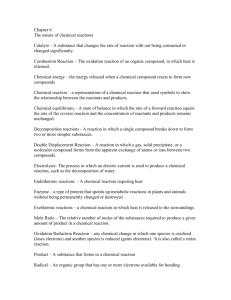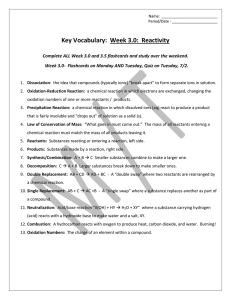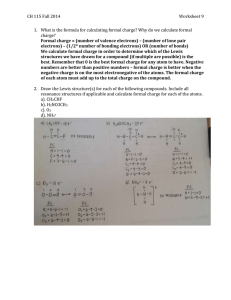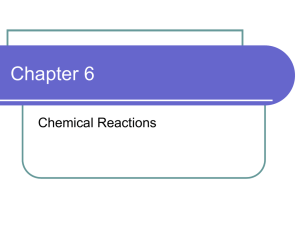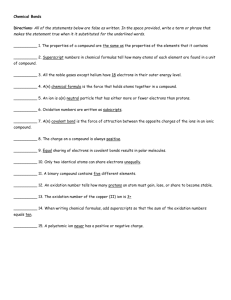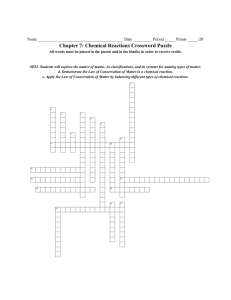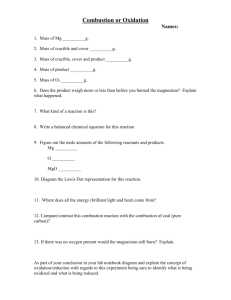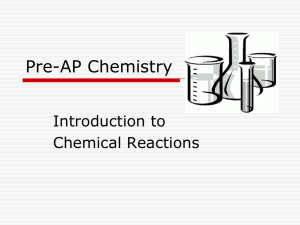2 - Images
advertisement
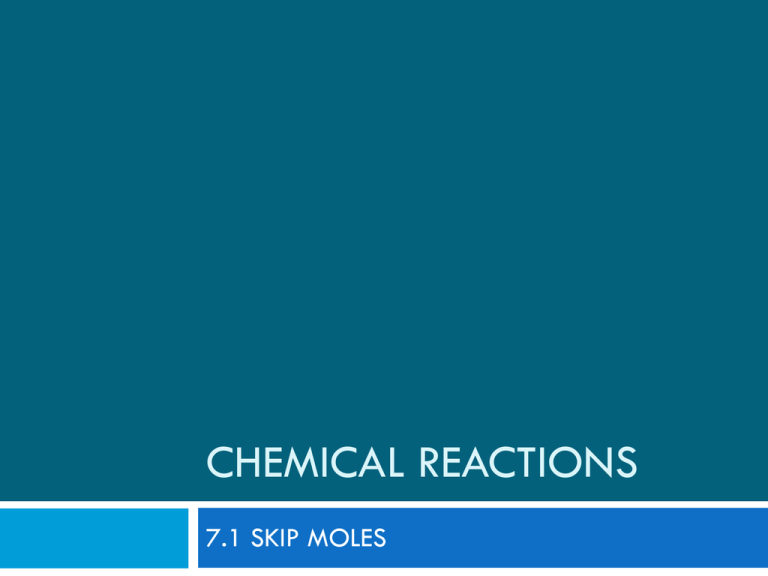
CHEMICAL REACTIONS 7.1 SKIP MOLES True False Statement Products are on the left, and yield reactants on the right of a chemical equation Law of conservation of mass says that matter (elements) cannot be created or destroyed When balancing equations you CAN change the subscripts, but NOT the coefficients Avogadro's number is 6.02 x 1023 which is about a mole Cu + O2 CuO Is balanced True False Chemical Reactions Chemical reactions change substances into new substances with new chemical and physical properties Ways to know a chemical reaction is occurring: A release of gas A color change Production of light and/or heat The production of a precipitate (solid) Parts of Chemical Reactions The Law of Conservation of Mass States that no matter can be created nor destroyed in a chemical reaction # on the left = # on the right Two parts of a chemical reaction Reactants: a substance or molecule that participates in a chemical reaction Usually Products: found on the left side of an equation a substance that is formed in a chemical reaction Usually found on the right side of an equation Parts of a chemical equation Coefficient Subscript 2 H2 + O2 2 H2O Products Reactants Atoms are rearranged in chemical reactions to make new substances by making or breaking bonds. Chemical Equations Chemical equation: A representation of a chemical reaction that uses symbols to show the relationship between the reactants and products CH4 + O2 CO2 + H2 O When balancing a chemical reaction you may add coefficients in front of the compounds to balance the reaction, but you may NOT change the subscripts. Changing the subscripts changes the compound!! Subscripts are determined by the valence electrons (charges for ionic or sharing for covalent) The subscripts tell you how many atoms of a particular element are in a compound. The coefficient tells you about the quantity, or number, of molecules of the compound 1. Write the correct formula for the reactants and the products. 2. Find the number of atoms for each element on the left side. Compare those against the number of the atoms of the same element on the right side. 3. Determine where to place coefficients in front of formulas so that the left side has the same number of atoms as the right side for EACH element 4. Check your answer to see if: The numbers of atoms on both sides of the equation are now balanced. The coefficients are in the lowest possible whole number ratios. (reduced) Write the equation that describes the burning of magnesium in air to form magnesium oxide. Magnesium + Oxygen (air) Magnesium Oxide 2 MgO Mg + O2 2 1 Mg 1 Mg 2 1O 2O Balanced! Potassium metal reacts violently with water to produce potassium hydroxide and hydrogen gas. Potassium + Water Potassium Hydroxide + Hydrogen Gas Math Practice pg 195 1. Balance the production of hydrogen chloride from hydrogen and chlorine Math Practice Balance H2O2 Mg H2O + O2 + HCL H2 + MgCl2 Math Practice Ethylene, C2H4 burns in the presence of oxygen to produce carbon dioxide and water vapor. Balance. Moles (Mol) is the amount of subatnce that contains about 6.02 x 1023 particles of that substance. Called Avagardo’s # Usually atoms, ions, or molecules Molar mass- mass of 1 mole of a substance TYPES OF REACTIONS Ch. 7.2 True False Statement A synthesis reaction is when a compound breaks down into 2 or more elements In single replacement 1 pair switches places, and usually has 2 compounds on both sides Combustion reactions always yield heat, light and water Oxidation reactions gain electrons, while reduction lose electrons AB A + B Is decomposition True False Types of reactions 5 Types of Reactions Synthesis Single Double Decomposition Combustion Synthesis Synthesis Reaction: A reaction in which two or more substances combine to form a new compound A + B AB Example: 2Na + Cl2 2NaCl Decomposition Decomposition Reaction: A reaction in which a single compound breaks down to form two or more simpler compounds. AB A + B Example: 2H2O 2H2 + O2 Single Displacement Single-Displacement Reaction: A reaction in which one element or radical takes the place of another element or radical in a compound AX + B BX + A Example: 3 CuCl2 + 2Al 2AlCl3 + 3Cu Double Displacement Double-Displacement Reactions: A reaction in which a gas, solid, or a molecular compound forms from the apparent exchange of atoms or ions between two compounds AX + BY AY + BX Pb(NO3)2 + K2CrO4 PbCrO4 + 2 K2 NO3 Combustion Combustion Reaction: The oxidation of an organic compound in which heat is released Also known as “burning” Always contain a hydrocarbon and oxygen from the air as reactants Always produce carbon dioxide, water, and heat CH4 + 2O2 → CO2 + 2H2O + heat LEO says GER!!! Electrons are sometimes transferred in chemical reactions These reactions are called oxidationreduction reactions (REDOX reactions) LEOLose Electrons = Oxidation Oxidation Substances that lose electrons are oxidized Reduction Substances that accept electrons are reduced GERGain Electrons = Reduction Oxidation or Reduction? Fe changes to Fe2+ Pb4+ F changes to Pb2+ changes to F1- Cr2+ changes to Cr3+ Mg2+ changes to Mg oxidation reduction reduction oxidation reduction ENERGY CHANGE AND REACTION RATES 7.3/4 True False Statement Endothermic releases energy/forms bonds, while exothermic absorbs energy/breaks bonds Increasing temperature speeds up the reaction rate The smaller the surface area and concentration, that faster the reaction rate A catalyst is a substance that speeds up a reaction without being consumed Reaction rate, is the rate at which products turn into reactants True False Energy is released or absorbed Endothermic Reaction Absorbs energy Energy is required to break bonds Exothermic Reaction Releases energy Energy is greater than energy needed to break bonds Conservation of Energy Energy is not created or destroyed in endothermic and exothermic reactions Total energy at beginning = total energy at end Reaction Rate Rate at which reactants change into products over time How fast reactants are being consumed How fast the products are being formed How fast energy is absorbed or released Factors Affecting Reaction Rate Temperature in temp= in rate Faster particles in temp= in rate Slower particles Surface Area in S.A= in rate More collisions Factors Affecting Reaction Rate Stirring collisions= in rate Ex: Washing machine Concentration # of particles in a given volume in conc.= in rate in pressure= in rate gases Factors Affecting Reaction Rate Catalyst Affects substance w/out being used up Speeds up reaction Written over yield arrow EQUILIBRIUM Ch 7.5 True False Statement Means an equation is reversible/at equilibrium Equilibrium means the forward and reverse paths of the reaction take place at the same rate There are 3 types of equilibrium-chemical, physical and atomic La Chatelier said when a change is introduced, the equation will do the opposite Temperature, pressure, and concentration affect equilibrium True False Equilibrium State in which the forward and reverse paths of change take place at the same rate Physical and Chemical Types of Equilibrium Physical Opposing physical change takes place at the same time Chemical Opposing chemical changes take place at the same time La Chatelier’s Principle When a change is introduced to a system in equilibrium, the equilibrium shifts in the direction that relieves the change Factors Affecting Equilibrium Temperature in temp will shift in the direction that removes heat from the system Pressure in pressure will shift in the direction that decreases the pressure of the system Factors Affecting Equilibrium Concentration Equilibrium will shift in direction that produces concentration
